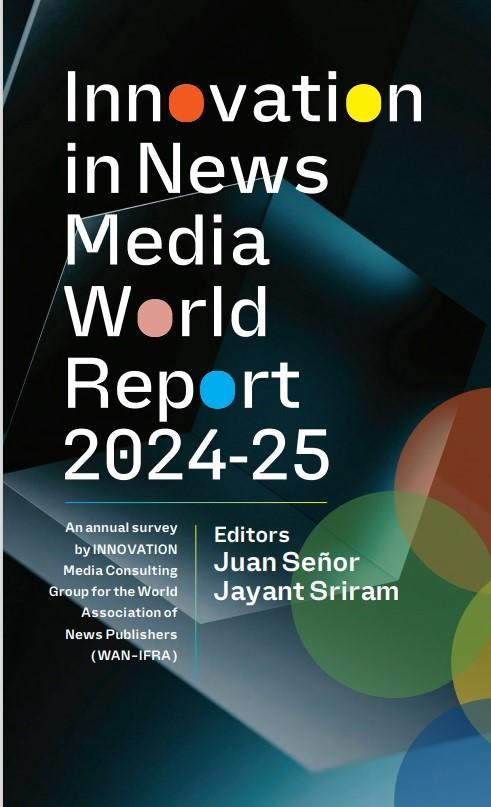
SEOUL, June 10 (AJU PRESS) - Newsrooms around the world are being upended by artificial intelligence (AI) at a pace that is leaving publishers scrambling to put strategies and guardrails in place. A new report by the World Association of News Publishers (WAN-IFRA) provides a comprehensive look at just how rapidly generative AI like ChatGPT has permeated newsrooms in the last year.
The annual report, titled "Innovation in News Media World Report 2024-25," is based on the results of multiple surveys and case studies showing major challenges faced by the global media industry, including AI technology, fact-checking, and business models.
"Generative AI has stormed its way into newsrooms across the world and now is the time to review and adapt," said the report from the global media organization, which claims 60 member publisher associations representing 18,000 publications in 120 countries.
“Concerns still persist, of course, about the technology eventually being used to replace journalists, and that is something the industry needs to band together to ensure that these tools are helpers and not replacements,” it added.
The report cited a survey by POLIS, the journalism think tank at the London School of Economics and Political Science, which showed an overwhelming 90 percent of news organizations are incorporating AI in news production, with 80 percent using it in news distribution and 75 percent in news gathering. It's a remarkable figure considering ChatGPT was only released to the public in late 2022. These applications include automated transcription and translation, extracting text from images, and web scraping for news gathering, proofreading and writing headlines, according to the WAN-IFRA report.
“Distribution efforts are enhanced by AI-driven search engine optimization and content personalization for specific audiences,” it added. The WAN-IFRA report also refers to a survey by the Reuters Institute for the Study of Journalism, which underscores the widespread belief among newsroom leaders in AI's potential impact on the industry.
Most newsroom leaders (74 percent) believe AI will help increase efficiencies without fundamentally altering journalism itself, while 21 percent foresee generative AI transforming workflows and processes, fundamentally altering every role in the newsroom. Only 2 percent think generative AI will leave news work unchanged.
![[Getty Images Bank]](https://image.ajunews.com/content/image/2024/06/10/20240610111055873491.jpg)
The WAN-IFRA report also highlights how AI is being utilized across the full news cycle. In newsgathering, tools like Dataminr are being used to analyze vast datasets to spot trends and potential stories. Optical character recognition and speech-to-text AI simplify the process of transcription and translation.
For news production itself, publishers are applying AI in areas like automated article summaries, search optimization for headlines and story angles, grammar checking, and even attempting to generate entire articles with human oversight.
AI is also becoming a part of news distribution strategies, with outlets using AI to personalize content for specific audience segments like younger or immigrant readers. Tools can adapt an article's tone and format for different demographics.
The report catalogs a wide range of compelling AI-powered experiments, from the San Francisco Chronicle's restaurant recommendation chatbot to the New York Times using generative AI for real-time targeted advertising.
However, there are also widespread concerns about the limitations and risks of generative AI. A report by Nic Newman, a journalist and digital strategist for the Reuters Institute, found news organizations perceive the highest risk (56 percent) around using AI for content creation, followed by newsgathering (28 percent). Back-end automation, distribution, and coding pose lower risks, the Newman report said.
To navigate the challenges, news leaders are taking different strategic approaches. Amedia, the second-largest media conglomerate in Norway, has created secure "AI sandboxes" allowing journalists to safely test out the technology with guidelines. The Washington Post, Reuters, and Financial Times have all published principles emphasizing human oversight.
"Reuters reporters and editors will be fully involved in – and responsible for – greenlighting any content we may produce that relies on AI," Alessandra Galloni, editor-in-chief, wrote in a memo.
Disclosure is another widely embraced practice, with outlets vowing to be transparent when any AI-assisted processes or tools are involved in published material.
However, the lack of strategic planning for AI at many newsrooms is also highlighted as a risk. Only about one-third have an AI strategy in place or are in the process of developing one, according to the POLIS report.
To assist in navigating the AI revolution, the POLIS report offers six steps towards an AI strategy for newsrooms: Get informed on the basics and current applications of generative AI; Improve overall AI literacy across the full organization; Assign AI strategy leaders; Continuously test and iterate with the technology gradually; Develop and publish guidelines around AI usage; Collaborate with other newsrooms, tech companies, and startups.
"AI will not be a panacea for the many deep-seated problems and challenges facing journalism and the public arena," the WAN-IFRA report cautioned.
"Technology alone cannot fix intractable political, social, and economic ills. News organizations will continue to be forced to make a case for why they still matter in the modern news environment — and why they deserve audiences’ attention and money.”
Copyright ⓒ Aju Press All rights reserved.



